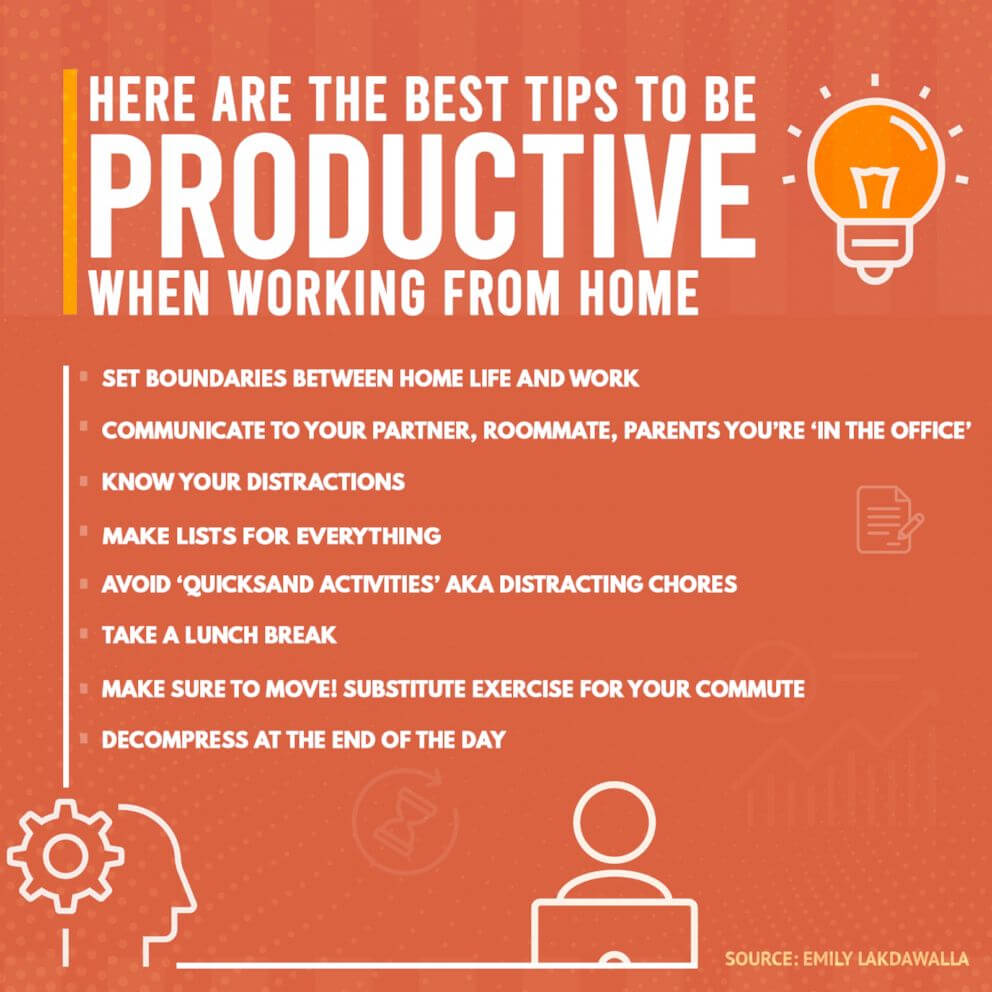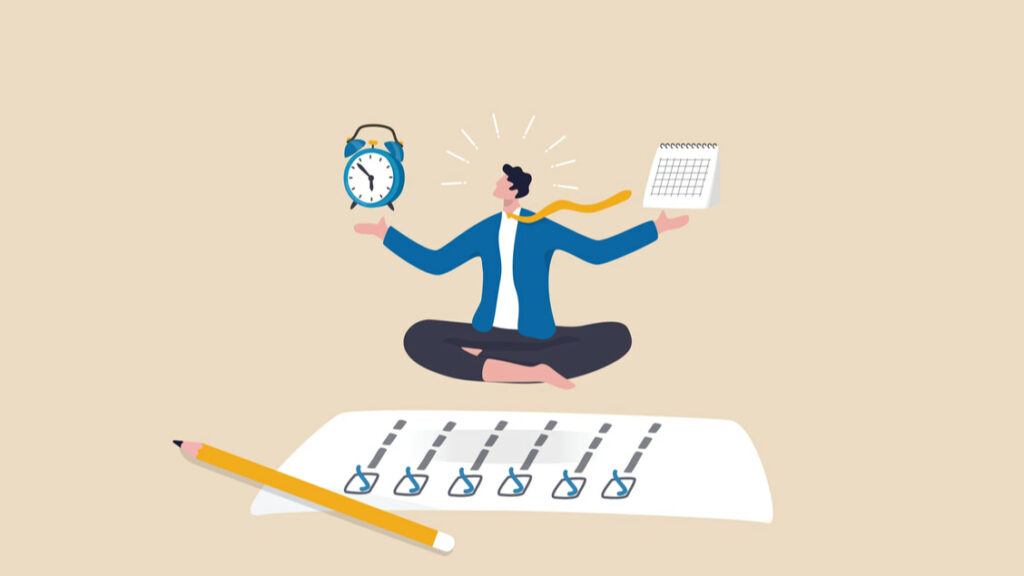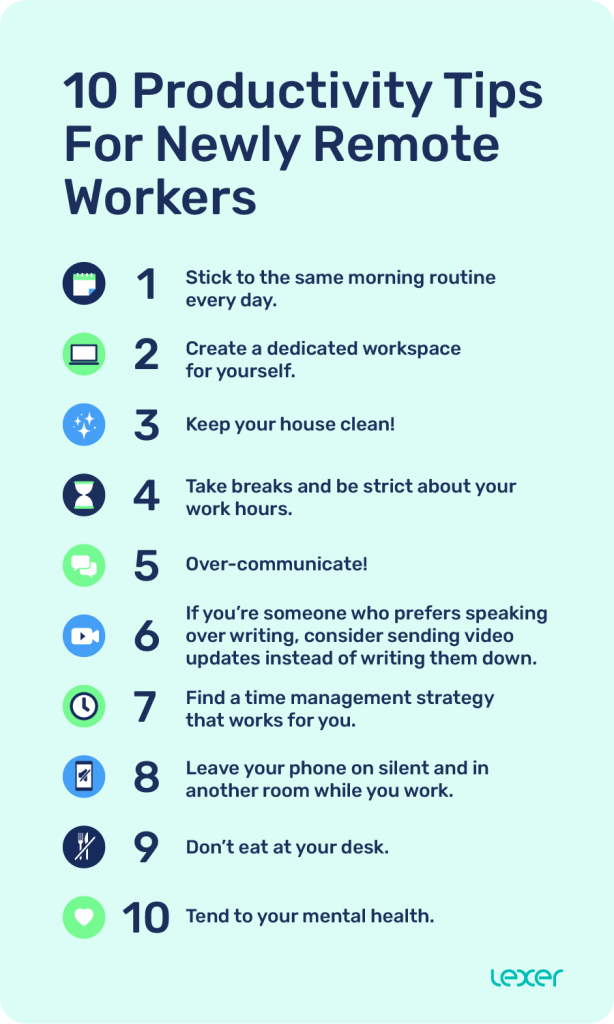Create a dedicated workspace and establish a routine to boost productivity as a remote worker. Limit distractions and take regular breaks.
Remote work offers flexibility but requires discipline. A well-structured environment helps maintain focus and efficiency. Start by setting up a dedicated workspace free from distractions. This space signals your brain it’s time to work. Establish a daily routine to create consistency.
Regular working hours help you stay on track. Schedule breaks to avoid burnout and keep energy levels high. Use productivity tools to manage tasks and deadlines. Effective communication with your team is crucial. Use video calls and messaging apps to stay connected. By implementing these strategies, remote work can be highly productive and rewarding.

Credit: krisp.ai
Setting Up Your Workspace
Creating an effective workspace is essential for remote work productivity. A well-organized workspace can boost your focus and efficiency. Let’s explore how to set up your workspace.
Choosing The Right Location
Select a quiet spot in your home. This will help you concentrate better. Avoid high-traffic areas. These spots can be distracting. Choose a place with natural light. It helps reduce eye strain.
Consider a separate room if possible. This creates a clear boundary between work and home life. If you lack a separate room, use dividers or curtains. They can help create a dedicated work area.
Ergonomic Essentials
Invest in a good chair. Your chair should support your back well. An adjustable chair is best. This allows you to find the perfect height and angle.
Place your computer screen at eye level. This prevents neck strain. Use a monitor stand if needed. Ensure your keyboard and mouse are at a comfortable height. Your arms should form a 90-degree angle.
Keep essentials within reach. This includes your phone, notepad, and pens. Avoid clutter. A tidy desk boosts productivity.
| Essential | Reason |
|---|---|
| Adjustable Chair | Supports back and improves posture |
| Monitor Stand | Prevents neck strain |
| Ergonomic Keyboard | Reduces wrist strain |
| Desk Lamp | Improves lighting and reduces eye strain |
Remember to take breaks. Stand up and stretch every 30 minutes. This will help prevent fatigue.
Creating A Routine
Creating a routine is key to being a productive remote worker. A well-structured routine provides stability and helps maintain focus. This section explores how to build an effective daily routine.
Morning Rituals
Start your day with a set of morning rituals. These set the tone for your workday. Here are some ideas for your morning routine:
- Wake up at the same time every day.
- Make your bed to signal the start of the day.
- Eat a healthy breakfast for energy.
- Take a shower to feel refreshed.
- Dress as if you are going to an office.
Morning rituals help you transition from home mode to work mode. They prepare your mind and body for a productive day.
Scheduling Breaks
Scheduling breaks is essential for maintaining focus and energy. Working non-stop can lead to burnout. Here’s how to effectively schedule breaks:
| Break Type | Frequency | Duration |
|---|---|---|
| Short Break | Every 60 minutes | 5-10 minutes |
| Lunch Break | Once a day | 30-60 minutes |
| Stretch Break | Every 2 hours | 5 minutes |
During breaks, do activities that refresh your mind and body:
- Take a walk outside.
- Do some light stretching.
- Grab a healthy snack.
- Listen to some music.
Scheduled breaks keep you energized and focused throughout the day.
Managing Time Effectively
Working from home offers flexibility but demands discipline. Managing time effectively is crucial for productivity. Here are some tips to help you manage your time better as a remote worker.
Prioritizing Tasks
Start by listing your tasks for the day. Identify the most important ones. These are your top priorities. Use the Eisenhower Matrix to categorize tasks:
| Urgent | Not Urgent | |
|---|---|---|
| Important | Do First | Schedule |
| Not Important | Delegate | Eliminate |
Focus on tasks that are both urgent and important. Schedule tasks that are important but not urgent. Delegate or eliminate the rest. This helps you stay organized and focused.
Using Time-blocking
Time-blocking is a powerful technique. Divide your day into blocks of time. Assign specific tasks to each block. This creates a structured schedule.
- Start with a list of tasks.
- Estimate the time needed for each task.
- Allocate blocks of time for each task.
For example:
- 9:00 AM – 10:00 AM: Check emails
- 10:00 AM – 12:00 PM: Work on project A
- 12:00 PM – 1:00 PM: Lunch break
- 1:00 PM – 3:00 PM: Meetings
- 3:00 PM – 5:00 PM: Complete project B
Stick to your schedule. Use tools like calendars or apps to set reminders. This keeps you on track and minimizes distractions.

Credit: arc.dev
Staying Connected
Staying connected is crucial for a productive remote work environment. Effective communication keeps everyone on the same page. It also fosters a sense of community among remote workers. Here are some tips to help you stay connected with your team.
Regular Team Meetings
Regular team meetings can make a big difference. They help you share updates and collaborate on projects. Schedule weekly or bi-weekly meetings. This keeps everyone informed and aligned with the company’s goals.
Use video conferencing tools like Zoom or Microsoft Teams. Face-to-face interaction, even virtually, builds better connections. Keep meetings short and focused. This ensures you respect everyone’s time.
Effective Communication Tools
Choose the right communication tools for your team. Different tools serve different purposes. Here are some popular options:
| Tool | Purpose |
|---|---|
| Slack | Instant messaging and quick updates |
| Trello | Project management and task tracking |
| Asana | Task management and team collaboration |
Use these tools to keep your team connected and organized. Effective communication boosts productivity and morale. It’s essential for any remote team.
Avoiding Distractions
Working remotely can be full of distractions. Staying productive requires effort. Learn how to avoid distractions with these tips.
Setting Boundaries
Create a dedicated workspace. This helps separate work from home life.
Communicate with family or housemates. Let them know your work hours.
Use a physical sign, like a closed door, to show you are working.
Minimizing Digital Interruptions
Turn off non-essential notifications. These can break your focus.
Use website blockers to avoid distracting sites during work hours.
Set specific times to check emails. Avoid checking constantly.
Keep your phone on silent mode. Check it only during breaks.
Maintaining Work-life Balance
Working from home can blur the lines between personal and professional life. It’s essential to maintain a clear boundary. This ensures productivity and mental well-being. Here are some tips to help you keep a healthy work-life balance.
Separating Work And Personal Time
Create a dedicated workspace. This helps to signal work mode. Avoid working from your bed or sofa. It confuses your mind and body.
Set clear working hours. Stick to them as much as possible. Let your family know your schedule. This reduces interruptions and misunderstandings.
Use tools like calendars and reminders. They help in managing tasks and time. This ensures you don’t overwork and have time for yourself.
Self-care Practices
Take regular breaks. Short breaks boost your productivity. Stand up, stretch, or take a walk. It helps in reducing stress and fatigue.
Practice mindfulness and relaxation. Meditation can improve focus and reduce anxiety. Even a few minutes can make a difference.
Maintain a healthy lifestyle. Eat balanced meals and stay hydrated. Regular exercise keeps your body and mind in shape.
| Tip | Description |
|---|---|
| Dedicated Workspace | Helps in maintaining work mode |
| Clear Working Hours | Reduces interruptions and overworking |
| Regular Breaks | Boosts productivity and reduces fatigue |
| Mindfulness | Improves focus and reduces anxiety |
| Healthy Lifestyle | Keeps body and mind in shape |
Leveraging Technology
Leveraging technology can significantly enhance your productivity as a remote worker. The right tools can streamline your workflow, keep you organized, and improve collaboration with your team. Below, we discuss some essential tools and platforms to boost your remote work efficiency.
Productivity Apps
Productivity apps help you manage tasks and stay on track.
- Todoist: This app lets you create and manage to-do lists. You can set priorities and deadlines.
- Trello: Trello offers a visual way to manage your projects. It uses boards, lists, and cards.
- Forest: This app helps you stay focused. You grow virtual trees by not using your phone.
Collaboration Platforms
Collaboration platforms make it easy to work with your team, no matter where they are.
| Platform | Features |
|---|---|
| Slack | Real-time messaging, file sharing, and integrations with other tools. |
| Zoom | Video conferencing, screen sharing, and meeting recording. |
| Asana | Task management, project timelines, and team collaboration. |
By using these tools, you can become a more effective remote worker. Start integrating them into your daily routine.

Credit: www.atlassian.com
Continuous Improvement
Continuous improvement is key to being a productive remote worker. This means always seeking ways to enhance skills and efficiency. Adopting a mindset of growth can boost both performance and satisfaction.
Seeking Feedback
Regular feedback helps identify areas for growth. It offers insights into strengths and weaknesses. Ask colleagues and managers for constructive criticism. Acting on feedback can lead to significant improvements.
Consider setting up bi-weekly or monthly reviews. Use a table to track feedback and progress:
| Date | Feedback | Action Taken | Result |
|---|---|---|---|
| 1st Oct | Improve email clarity | Used bullet points | Faster responses |
| 15th Oct | Better time management | Used a timer | Completed tasks quicker |
Learning New Skills
Learning new skills keeps you adaptable. It also enhances job performance. Remote workers should explore online courses and webinars. Platforms like Coursera and Udemy offer a wide range of subjects.
Here is a simple list to get started:
- Identify a skill you want to learn.
- Find an online course or tutorial.
- Dedicate an hour each week to study.
- Apply what you learn to your work.
Regularly update your knowledge. Stay current with industry trends. This can make you invaluable to your team.
Frequently Asked Questions
How Can I Stay Focused While Working Remotely?
To stay focused, create a dedicated workspace free from distractions. Set clear goals and use time management tools. Take regular breaks to recharge and maintain productivity.
What Tools Help Remote Workers Be Productive?
Productivity tools like Trello, Slack, and Zoom facilitate communication and task management. Time-tracking apps like Toggl help monitor work hours and maintain focus.
How Do I Manage Time Effectively As A Remote Worker?
Effective time management involves creating a daily schedule, prioritizing tasks, and using techniques like the Pomodoro Technique. Consistent routines improve productivity and work-life balance.
How Can I Avoid Burnout While Working Remotely?
Avoid burnout by setting clear boundaries between work and personal time. Take regular breaks, exercise, and ensure you have downtime to relax and recharge.
Conclusion
Mastering remote work takes time and practice. Implement these tips to boost your productivity and efficiency. Stay disciplined, set clear goals, and maintain a healthy work-life balance. With dedication, you can thrive in a remote work environment. Embrace these strategies and watch your productivity soar.

